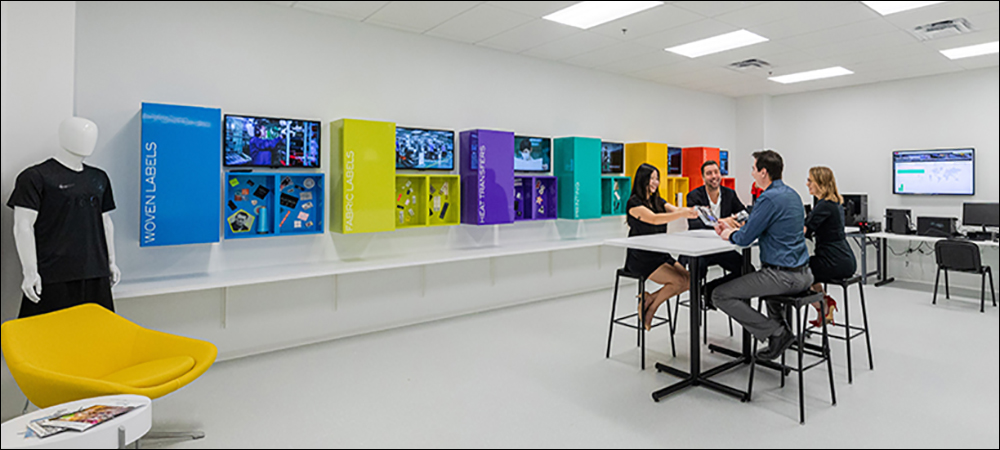Technology company SML launched its RFID Ideation Space (RIS) at its Plano, Texas, headquarters in 2019 to allow potential customers and partners to physically experience how RFID technology works in a real-life setting (see SML Opens Retail Ideation Space for Item-Level RFID). At that time, says Dean Frew, SML’s CTO and senior VP of RFID solutions, no one could have foreseen how limited travel and physical visits would be in 2020. However, the company has now built a way to access its site through virtual experiences, in which companies can take a tour without their employees physically being there. RIS facilities are also in place in China and the United Kingdom, and the company plans to offer virtual access to these sites as well in the near future.
SML calls its digital version of the RIS its Virtual Immersion Experience in Item-level RFID, and says it began informally hosting digital events with retailers and brand owners this past spring, which has led to multiple contracts and deployments. Prior to the COVID-19 pandemic, SML’s RIS center was used by potential customers to view how the technology works, get the RFID readers and software into their hands, and build out the best use case for their needs. Partners and customers have also used the site for training purposes, Frew says, in order to acquaint workers who will be utilizing the technology.

Dean Frew
SML travels to customers’ facilities to assist with this process, Frew says, and it has begun doing so again. However, for those that want to take a look or build out a solution without traveling, SML has set up a virtual experience that comes as close to a live center as the company can offer. The virtual system leverages cameras installed above each room when the RIS was designed a year ago, and users can enter the space by viewing it through camera lenses on a conference call. “Little did we know,” he states, “the virtual system was going to be so useful for customers and a competitive advantage.”
The virtual system was first provided to a customer whose deployment was in the planning stage, just as the pandemic had arrived. SML was able to demonstrate the technology and train others over the air, Frew recalls. The company also used the system for demos during the recent RFID Journal Virtually LIVE! conference and exhibition. The virtual demos are essential for SML now, he notes, since the demand for RFID solutions has been ticking up during the pandemic. “Sales cycles are moving faster than they were even a year ago,” Frew states, due in part to the heightened need for “buy online, pickup in store” (BOPIS), as well as curbside pickup and other new models of retail product delivery.
With the virtual space, companies can set up a Zoom appointment. The system taps into views from the cameras deployed at the store front and in the shipping area and warehouse, enabling users to view the system in real-life settings in an interactive way. For instance, the solution allows users to watch associates live, reading tag IDs via handheld and fixed readers. Users can view how the technology can be employed not only for inventory counting and BOPIS, but also for such purposes as loss prevention, point-of-sale and the customer experience, such as interactive kiosks.
SML provides a portfolio of tags and software, including its Inspire encoded UHF RFID tags, and it provides 24 service bureaus globally. The company’s Clarity software, which manages RFID tag-read data, has been deployed at 3,800 stores, Frew reports, and that number is growing this year. He estimates that SML’s customers have increased sales by more than $2 billion. During his Virtually LIVE! presentation, he reported that SML delivered more than 2 billion RFID tags for retail last year.
With the virtual demos, Frew says, “We’re able to use the application to zero in on a set of use cases.” The next step, once an application is defined, “is to configure the solution and get it into their hands.” The company has a single camera on the sales floor, another in the stock room and a third in the warehouse area, though it is currently planning ways to expand the experience for those who opt for the virtual connection rather than a physical visit. “We will add some visibility” during the coming months, he says, with more cameras. During each call, SML’s personnel demonstrate the RFID functionality a potential customer seeks, such as stock counting and BOPIS.
“We’re doing the demos probably weekly,” Frew reports. “It’s very efficient. We’ve been surprised.” In fact, he adds, while using the virtual demos and training, “We’ve won six deals in 60 days, many because we were able to provide this virtual access to a real system executing real processes in a store.” The system also enables the training of partners or customers. The company has conducted virtual workshops in which it has laid out different approaches for the RFID application at its own site or at customers’ facilities. “What we’ve been able to do is use the application, because of the modularity and configurability of it, to zero in on a set of use cases that might be acceptable to that client.”
The next step for SML is to configure a solution and get that technology into the user’s hands. The company often travels to a customer’s or partner’s site to accomplish this goal. SML next plans to deploy the virtual technology, including cameras, in Shanghai and near London. “Who would have thought we could train customers or partners around the globe in this way?” Frew muses. The company has the capacity to provide multiple virtual tours, training sessions and workshops per day. For SML’s RFID safes staff, he says, the fact that they now can close deals without travelling benefits them and the customers alike. Although the system has been in use for months, SML recently announced it based on its effectiveness.
The company has noticed a greater demand for item-level RFID technology during the pandemic, Frew sys, and it finds that retailers that have deployed the technology gain an advantage in serving customers over others that don’t yet use the technology. Those that were already using RFID came through the outbreak more smoothly, Frew explains, since they were able to view the locations of goods delayed in the supply chain and use inventory visibility to resume sales with BOPIS and curbside pickup service. In fact, he adds, “Retailers have accelerated their move to stores operating as distribution centers,” meaning shoppers can place an order and have it fulfilled from a neighborhood store, thereby reducing the amount of time they would otherwise spend browsing shelves.
SML says it sees opportunities to bring artificial intelligence (AI) into RFID solutions for replenishment adjustments, as part of what Frew calls “BOPIS 2.0.” That means, for instance, using data related to weather—such as a cold front in one geographic region—to launch sales efforts, like moving merchandise related to cold weather onto the sales floor. He predicts a combination of RFID and electronic article surveillance (EAS) tags will be offered in the future, for which SML has a new product announcement ahead.
Additionally, Frew says, new RFID readers and tags will offer faster performance so that inventory counts can take place in less time, further freeing up store associates. Whereas RFID deployments initially were focused on a few product categories, he reports, “We’re seeing numerous retailers rapidly move toward 100 percent RFID-tagged products.” Such goods are tagged whether they are sold online or are on display or stored at a retail site.
Moving forward, Frew predicts “Were going to deal with better, faster, cheaper technology with even better ROIs,” such as RFID tags and readers. Those technology improvements will bring more retailers to RFID for the first time. “When you think of the market, only 10 percent is penetrated with RFID” in North America and Europe, he states. “We’ve still got a long way to go.” SML’s RIS is focused on apparel, but the space also includes research and development, with tags being designed for beauty products and other goods, as well as sewn-in labels for use in apparel.


